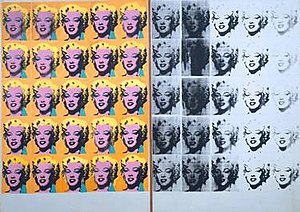Pop Art Marilyn Monroe Black and White
Silkscreen painting by Andy Warhol
| Marilyn Diptych | |
|---|---|
 | |
| Artist | Andy Warhol |
| Year | 1962 |
| Medium | Acrylic paint on canvas[1] |
| Dimensions | 205.44 cm × 289.56 cm (80.88 in × 114.00 in) |
| Location | Tate |
The Marilyn Diptych (1962) is a silkscreen painting by American pop artist Andy Warhol depicting Marilyn Monroe.
The monumental work is one of the artist's most noted of the movie star.
The painting consists of 50 images.[2] Each image of the actress is taken from the single publicity photograph from the film Niagara (1953). The underlying publicity photograph that Warhol used as a basis for his many paintings and prints of Marilyn, and the Marilyn Diptych, was owned and distributed by her movie studio. Marilyn Diptych was completed just weeks after Marilyn Monroe's death in August 1962.
Silk-screening was the technique used to create this painting. The twenty-five images on the left are painted in color, the right side is black and white.
The Marilyn Diptych is in the collection of the Tate.[3]
Analysis [edit]

This photograph of Marilyn Monroe is based on publicity portrait.
It has been suggested that the relation between the left side of the canvas and the right side of the canvas is evocative of the relation between the celebrity's life and death.[1] [4] [5] The work has received praise from writers such as American academic and cultural critic Camille Paglia, who wrote in 2012's Glittering Images lauding how it shows the "multiplicity of meanings" in Monroe's life and legacy.[6]
In a December 2, 2004 article in The Guardian, the painting was named the third most influential piece of modern art in a survey of 500 artists, critics, and others.[7] The artwork was also ranked ninth in the past 1000 years by Kathleen Davenport, Director, Rice University Art Gallery, Houston.[8]
The artwork was bought by art / design show organizer / collector Emily Hall Tremaine out of Warhol's studio in 1962, among several other noted early works by Warhol. Tremaine is noted for suggesting the two panels be put together, to which Warhol agreed. With her own celebrity media coverage implosion two decades earlier, the diptych is considered autobiographical for her. Tremaine sold the work to the Tate Gallery in 1980. Over the years, Marilyn Diptych has been in numerous exhibitions, including Witty, Sexy, Gimmicky: Pop 1957-67 at Tate Modern, April 27, 2015 - January 10, 2016.[9]
Appropriation and fair use [edit]
Warhol is regarded as one of the most well known appropriation artists and he often made use of publicity photographs and publicly available photographs and motifs not owned by him, which often brought him into conflict with the owners of the source material. An example of this is Warhol's Marilyn series including the Marilyn Diptych, which resulted in a settlement with the owner of the Marilyn Monroe publicity photograph which he used as the source material for the paintings. Warhol and his estate have settled many copyright disputes including with regard to his famous flowers paintings and paintings of Jackie Kennedy, as discussed in detail in "Andy The Appropriator: The Copyright Battles You Won't Hear About at The Whitney's Warhol Exhibit" from The Columbia Journal of Law & the Arts:
"Although some of Warhol's work was commissioned by individuals or companies, much of it was appropriated from other artists, photographers, and brands. Two of his most famous pieces, Marilyn Diptych and the collection of Campbell's soup cans, are examples of his habit of appropriation. For the Marilyn series, Warhol took a promotional photograph of Marilyn Monroe and transferred it onto silkscreen print using different colors. He did not own the promotional photograph that he used and he did not have permission to use it. The resulting work was transformative enough that a strong fair use argument could be made today, but Warhol's appropriation is undeniable. Similarly, Warhol used the Campbell's Soup logo without permission from the company for dozens of silkscreen prints. Eventually, Campbell's Soup tacitly approved of his use because of the free marketing they were receiving, but Warhol's use of their logo without initial permission was still appropriation."[10]
See also [edit]
- Gold Marilyn Monroe, another 1962 work by Warhol featuring Monroe
References [edit]
- ^ a b "Andy Warhol Marilyn Diptych 1962". Tate. February 2016. Retrieved 2018-10-14 .
- ^ "Marilyn Diptych".
- ^ [1] Andy Warhol; Marilyn Diptych 1962. Tate Museum web page
- ^ Helen Gardner, et al. Gardner's Art Through the Ages. Thompson Wadsworth, 2004. 1054.
- ^ Carol Salus. "Behind the Celestial Enchantment". The Poetry of Life in Literature. Ed. Anna-Teresa Tymieniecka. Springer, 2000. 198.
- ^ Rosen, Gary (October 16, 2014). "The Pagan Aesthetic". The Wall Street Journal . Retrieved July 17, 2014.
- ^ Charlotte Higgins. "Work of art that inspired a movement ... a urinal". The Guardian. December 2, 2004. Retrieved October 22, 2019.
- ^ (May 19, 2000). Which art will top the Chartres? Four curators share their Top 10 picks and reasoning behind the most influential visual artworks of the past 1,000 years. Christian Science Monitor, p. 12. Retrieved October 22, 2019.
- ^ Andy Warhol. Marilyn Monroe diptych, (1962). (March 15, 2019). artdesigncafe.com. Retrieved August 11, 2021.
- ^ "Andy The Appropriator: The Copyright Battles You Won't Hear About at The Whitney's Warhol Exhibit | The Columbia Journal of Law & the Arts". journals.library.columbia.edu . Retrieved 2021-03-31 .
External links [edit]
- Analysis of Andy Warhol's Marilyn Monroe Series (1967), including Maryiln Diptych (1962)
Pop Art Marilyn Monroe Black and White
Source: https://en.wikipedia.org/wiki/Marilyn_Diptych
0 Response to "Pop Art Marilyn Monroe Black and White"
Post a Comment